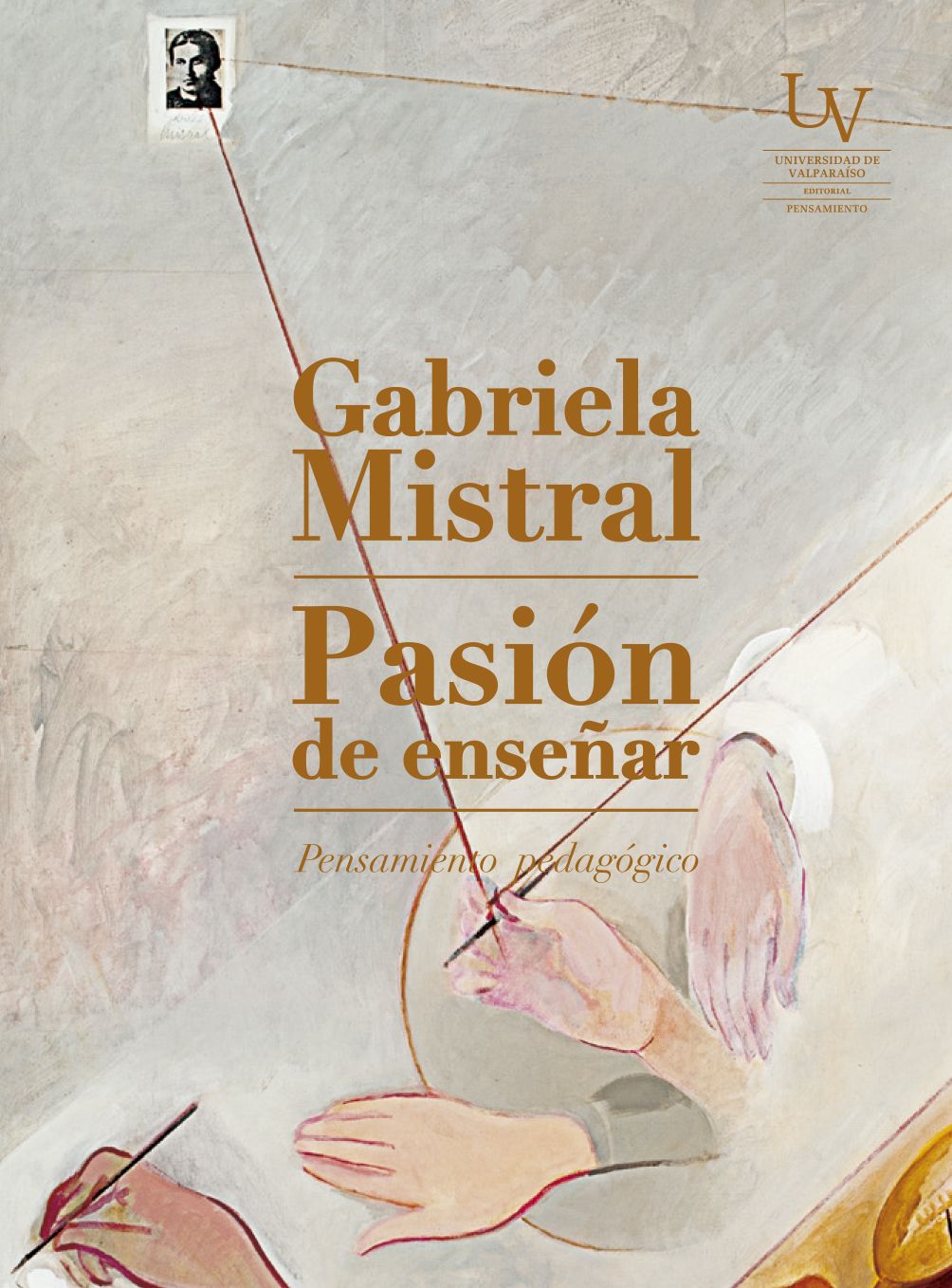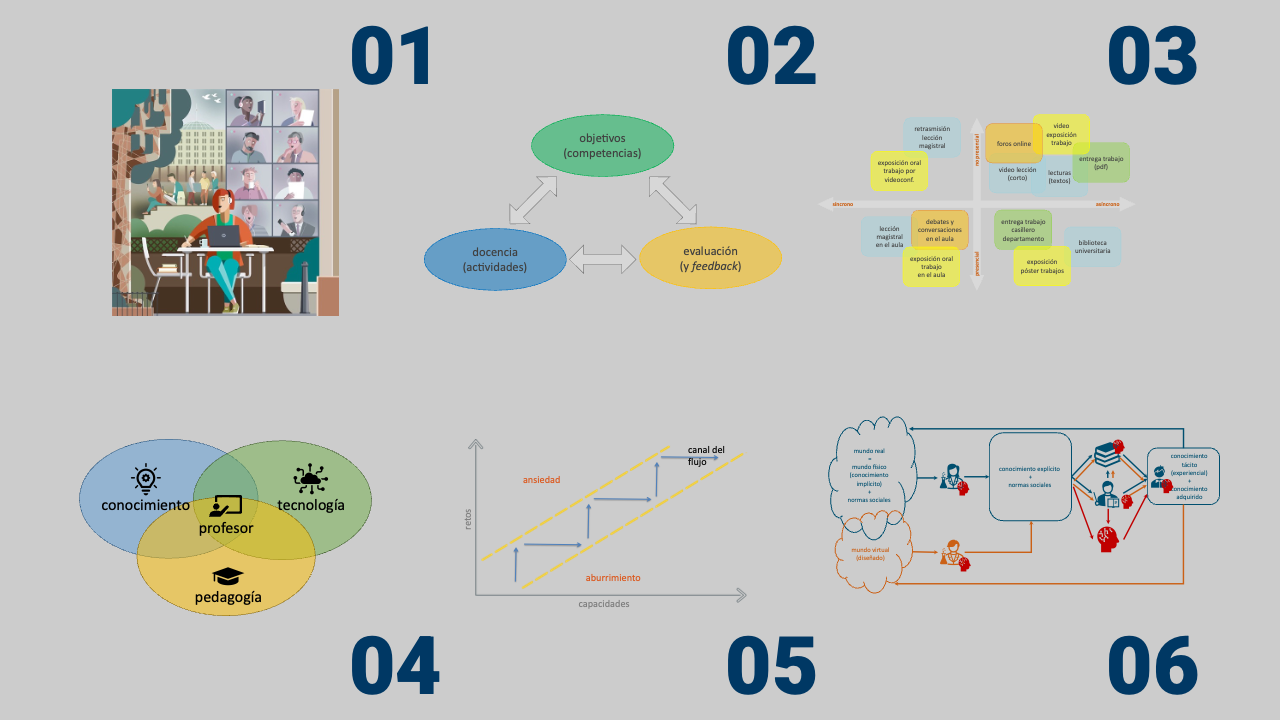Home » Innovación educativa
Category Archives: Innovación educativa
Pasión de enseñar
Pasión de enseñar.
Pensamiento pedagógico
Gabriela Mistral
Editorial de la Universidad de Valparaiso (https://editorial.uv.cl)
https://editorial.uv.cl/catalogo/pensamiento/53-pasion-de-ensenar

Frases entresacadas e ideas interesantes que puedo utilizar:
(Página )
“”
Mi experiencia con la IA generativa en mis clases de lógica: útil pero no fiable
Mi experiencia con la IA generativa en mis clases de lógica: útil pero no fiable
Faraón Llorens Largo, Universidad de Alicante.
La Inteligencia Artificial y su aplicación en la práctica profesional
Colegio Oficial de Doctores y Licenciados en Filosofía y Letras y en Ciencias de Alicante
Docentes y Profesionales de la Cultura
www.cdlalicante.org
Boletín Edición Alicante
2º semestre 2024, nº 44
www.cdlalicante.org/es/boletines
La IA generativa
Desde la aparición de ChatGPT en noviembre de 2022, la IA generativa ha captado la atención de todos, especialmente en el ámbito educativo, que está siendo convulsionado. La capacidad de crear (generar) textos nuevos, basados en todos los que ha leído (con los que ha sido entrenada), pero distinto a todos ellos, pone en solfa los trabajos académicos que nuestros estudiantes nos entregan. La evaluación académica basada en productos entregables se sustenta en dos pilares: la calidad del trabajo presentado y su autoría. Esta doble componente se hizo evidente durante la pandemia, en la que perdimos la seguridad sobre la autoría de los trabajos realizados.
Ahora, la IA generativa desafía la autenticidad de todo. ¡Ya no podemos estar seguros ni de lo que vemos!
Para ilustrar el impacto de la IA generativa en el entorno educativo, me centraré en algunos experimentos que he realizado en mi asignatura de Lógica, en el primer curso del Grado en Ingeniería en Inteligencia Artificial.
/…/
Poniendo en valor las preguntas y el diálogo
Considerar que ChatGPT lo sabe todo es no solo un error, sino también una actitud peligrosa y temeraria. Sin embargo, como herramienta, la IA generativa es extremadamente potente. Utilizar estos sistemas para corregir automáticamente ejercicios académicos no resulta recomendable, ya que la precisión y la claridad de las respuestas dependen en gran medida de cómo se plantean las preguntas. De ahí surge un nuevo perfil: la ingeniería de prompts.
Pero una de las aplicaciones más interesantes en el ámbito educativo es emplear la IA generativa como un medio para fomentar la interacción y el pensamiento crítico. En lugar de tomar sus respuestas como verdades absolutas, debemos utilizarlas como punto de partida para entablar un diálogo reflexivo sobre el tema en cuestión. Asumir la IA como un oráculo infalible es un grave error. Utilizarla como compañera de discusión siguiendo el método socrático puede ser seductor.
Estas consideraciones nos llevan a reflexionar sobre la evaluación del aprendizaje de nuestros estudiantes, sugiriendo que debemos transitar de una evaluación centrada en productos finales y respuestas correctas hacia una evaluación basada en el proceso y caracterizada por la capacidad de hacerse preguntas.
An interactive didactic application to learn collision detection techniques
An interactive didactic application to learn
collision detection techniques
Jorge Reig Valera, Faraón Llorens Largo, and Francisco J. Gallego-Durán
University of Alicante, Alicante, Spain
Technological Ecosystems for Enhancing Multiculturality (TEEM 2024)
23-25 October 2024
Alicante, Spain
2024.teemconference.eu
Proceedings
Lecture Notes in Educational Technology
Abstract.
This paper introduces an interactive educational application. It features a sandbox environment with various scenarios where different collision detection algorithms are utilized and visualized. This setup allows users to interact with and gain a comfortable and efficient understanding of how these algorithms work internally. Developed by a single person using raw C++ programming and basic rendering libraries, this paper presents an application that aims to assist anyone interested in entering the field of physics simulation and collision detection. It is suitable for beginners looking to start learning, experienced users seeking to refresh their knowledge, and teachers who wish to offer this tool to their students as a supplementary learning resource.
Keywords:
Collision Detection, Physics, E-learning software, Algorithm.
Exploring Stress in Effective Communication: A Psycho-Cognitive and Technological Approach
Exploring Stress in Effective Communication: A
Psycho-Cognitive and Technological Approach
Vanesa Dimitrova-Spiridonova, Faraón Llorens-Largo, and Alberto Real-Fernández
University of Alicante, Alicante, Spain
Technological Ecosystems for Enhancing Multiculturality (TEEM 2024)
23-25 October 2024
Alicante, Spain
2024.teemconference.eu
Proceedings
Lecture Notes in Educational Technology
Abstract.
Effective communication is crucial in all areas of life, especially in high-pressure situations such as public presentations. This study focuses on how stress affects people who present in front of audiences, compromising their accuracy and fluency. By combining cognitive psychology and the Internet of Things (IoT), IoT devices have been used to measure and visualize stress in real time. An experiment was conducted with fourth-year Multimedia Engineering students at the University of Alicante, who presented their academic projects. During these presentations, physiological data such as heart rate, breath rate, and stress levels were collected using IoT devices. The data collected demonstrated that these devices can effectively measure variables related to stress. Additionally, a web interface was developed to visualize the collected data, making it easier to interpret. This tool can be useful for specialists analyzing similar data or for teachers aiming to help their students improve their communication skills by identifying high-stress moments and developing strategies to enhance their presentation experience.
Keywords:
stress, effective communication, Internet of Things, cognitive psychology.
Tecnología y educación
Tecnología y educación
Taller
Ponente: Faraón Llorens
Congreso Internacional sobre Aprendizaje y Nuevas Vías de Innovación (CANVIES 2024)
18 de octubre de 2024
https://web.ua.es/canvies2024
Descripción del taller:
Tecnología y educación. No hemos utilizado preposiciones para conectar estos dos términos (tecnología para la educación, educación con tecnología o educación sin tecnología) porque cualquier intento de definir la relación de antemano nos limitaría. La conjunción “y” nos abre un universo de posibilidades: cooperación, conflicto, equilibrio, dependencia… La tecnología puede potenciar al profesorado, transformar la enseñanza y abrir nuevas vías para que el estudiantado explore y aprenda. Pero también puede distraer, complicar y, si no se utiliza con intención, restar más de lo que suma. Hoy es innegable que las tecnologías digitales han cambiado nuestra forma de relacionarnos y las competencias necesarias en el mundo actual. Y lo más emocionante es que la inteligencia artificial aún no ha irrumpido del todo en nuestras aulas. ¿Estamos preparados para lo que viene? ¿Cómo podemos ser protagonistas activos en esta transformación, en lugar de simples espectadores?
Este taller invita a reflexionar sobre las oportunidades, los retos y las incógnitas que plantea este diálogo entre tecnología y educación.
https://web.ua.es/es/canvies2024/talleres.html

Futuro Educativo: Innovación Docente Universitaria
Mesa Redonda
Futuro Educativo: Innovación Docente Universitaria Creando caminos hacia un mañana transformador
Faraón Llorens Largo, Universidad de Alicante.
Maria Asunción Martínez Mayoral, Universidad Miguel Hernández de Elche.
Antonio Fernández Coca, Universitat de les Illes Balears.
8 de octubre de 2024
Lugar: Salón de Actos del Aulario II
Congreso Internacional sobre Aprendizaje y Nuevas Vías de Innovación (CANVIES 2024)
https://web.ua.es/canvies2024

AI in Education Integration Checklist
AI in Education Integration Checklist
This checklist is designed to guide the evaluation and integration of AI tools in educational settings, ensuring they align with the principles of the Safe AI in Education Manifesto.
This checklist is designed to be used by educators, technologists, and educational institutions to evaluate and integrate AI tools in education.
Safe AI in Education Manifesto
Safe AI in Education Manifesto
http://manifesto.safeaieducation.org
Preamble
In the rapidly evolving landscape of education, Artificial Intelligence (AI) holds great promise to enhance learning experiences, streamline administrative tasks, and support both students and educators. However, with these advancements come significant responsibilities.
The Safe AI in Education Manifesto establishes the foundational principles that ensure AI is deployed in educational settings in a manner that is ethical, secure, and aligned with the core objectives of education.
This principles are intended to provide a framework to guide educators, educational institutions, developers and AI vendors in their decision making process about the use of AI in education.
Principle 1: Guaranteeing Confidentiality
Principle 2: Alignment with Educational Strategies
Principle 3: Alignment with Didactic Practices
Principle 4: Accuracy and Minimization of Errors
Principle 5: Comprehensive Interface and Behavior
Principle 6: Ethical Training and Transparency
Conclusion
The integration of AI into education is inevitable and holds great potential. However, this integration must be guided by principles that prioritize the well-being, privacy, and educational success of students. The Safe AI in Education Manifesto is a commitment to these principles, ensuring that AI enhances the educational experience without compromising ethical standards or educational integrity.
Tools to Support the Design of Network-Structured Courses Assisted by AI
Tools to Support the Design of Network-Structured Courses Assisted by AI
Juan-Luis López-Javaloyes, Alberto Real-Fernández, Javier García-Sigüenza, Faraón Llorens-Largo, & Rafael Molina-Carmona
26th International Conference on Human-Computer Interaction (HCII 2024)
Washington DC, USA
29 June – 4 July 2024
11th International Conference on Learning and Collaboration Technologies (LCT 2024).
Lecture Notes in Computer Science book series (LNCS,volume 14724) (https://link.springer.com/chapter/10.1007/978-3-031-61691-4)
https://link.springer.com/chapter/10.1007/978-3-031-61672-3_4
https://doi.org/10.1007/978-3-031-61672-3_4
Abstract
The integration of Information Technologies into education has lately focused on implementing learning systems to enhance the educational experience through innovative teaching methodologies. The rise of Artificial Intelligence has enabled the development of advanced strategies and algorithms, catering to individual learning styles. However, implementing these innovative approaches requires teachers to learn during the design and structuring of course content. As an example of this we have Khipulearn, a learning platform based on Customised Adaptive Learning Model (CALM), that offers a personalized educational experience. It allows the teachers to structure knowledge into interconnected competences, forming a competence graph for learners to navigate. The platform also employs an AI algorithm to select activities based on learners’ characteristics and needs. We propose two tools for teachers to optimize course design on Khipulearn. The first tool, a shortest path viewer, helps identify critical competences, providing control over essential knowledge of the course. The second tool visualizes the number of activities required for each competence, aiding in improving the efficiency on an adaptive activity selection. These tools aim to streamline the design process, ensuring teachers can leverage CALM’s adaptability and personalization principles without hindrance on the Khipulearn platform.
Keywords
learning design · AI tools · graph structure
Cite this paper as:
López-Javaloyes, JL., Real-Fernández, A., García-Sigüenza, J., Llorens-Largo, F., Molina-Carmona, R. (2024). Tools to Support the Design of Network-Structured Courses Assisted by AI. In: Zaphiris, P., Ioannou, A. (eds) Learning and Collaboration Technologies. HCII 2024. Lecture Notes in Computer Science, vol 14722. Springer, Cham. https://doi.org/10.1007/978-3-031-61672-3_4

Evolution of the Adoption of Generative AI Among Spanish Engineering Students
Evolution of the Adoption of Generative AI Among Spanish Engineering Students
Faraón Llorens-Largo, Rafael Molina-Carmona, Alberto Real-Fernández, & Sergio Arjona-Giner
26th International Conference on Human-Computer Interaction (HCII 2024)
Washington DC, USA
29 June – 4 July 2024
11th International Conference on Learning and Collaboration Technologies (LCT 2024).
Lecture Notes in Computer Science book series (LNCS,volume 14724) (https://link.springer.com/chapter/10.1007/978-3-031-61691-4)
https://link.springer.com/chapter/10.1007/978-3-031-61691-4_20
https://doi.org/10.1007/978-3-031-61691-4_20
Abstract
The irruption of ChatGPT has led to a technological change that could affect all sectors, concretely education. University students are facing this change, and the adoption of generative AI will be key to both their learning and job performance. This paper aims to study the adoption and evolution of generative AI among engineering students by analysing two surveys conducted in 2022 and 2023. The results show that engineering students are mostly aware and they are using generative AI tools. On the other hand, it has been studied whether gender can influence their adoption, and the results do not indicate significant changes. Regarding the evolution of the adoption of generative AI, a great change is shown, since it is being more used in all fields, also in education. This change indicates the attitude of engineering students to explore and take advantage of innovative tools, which can have a current and future impact on their learning and development.
Keywords
Generative AI · Technology Adoption · ChatGPT
Cite this paper as:
Llorens-Largo, F., Molina-Carmona, R., Real-Fernández, A., Arjona-Giner, S. (2024). Evolution of the Adoption of Generative AI Among Spanish Engineering Students. In: Zaphiris, P., Ioannou, A. (eds) Learning and Collaboration Technologies. HCII 2024. Lecture Notes in Computer Science, vol 14724. Springer, Cham. https://doi.org/10.1007/978-3-031-61691-4_20